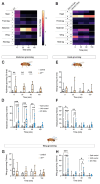This is a preprint.
Neurofibromin deficiency alters the patterning and prioritization of motor behaviors in a state-dependent manner
- PMID: 39149363
- PMCID: PMC11326213
- DOI: 10.1101/2024.08.08.607070
Neurofibromin deficiency alters the patterning and prioritization of motor behaviors in a state-dependent manner
Update in
-
Neurofibromin Deficiency Alters the Patterning and Prioritization of Motor Behaviors in a State-Dependent Manner.J Neurosci. 2025 Apr 16;45(16):e1531242025. doi: 10.1523/JNEUROSCI.1531-24.2025. J Neurosci. 2025. PMID: 39965929
Abstract
Genetic disorders such as neurofibromatosis type 1 increase vulnerability to cognitive and behavioral disorders, such as autism spectrum disorder and attention-deficit/hyperactivity disorder. Neurofibromatosis type 1 results from loss-of-function mutations in the neurofibromin gene and subsequent reduction in the neurofibromin protein (Nf1). While the mechanisms have yet to be fully elucidated, loss of Nf1 may alter neuronal circuit activity leading to changes in behavior and susceptibility to cognitive and behavioral comorbidities. Here we show that mutations decreasing Nf1 expression alter motor behaviors, impacting the patterning, prioritization, and behavioral state dependence in a Drosophila model of neurofibromatosis type 1. Loss of Nf1 increases spontaneous grooming in a nonlinear spatial and temporal pattern, differentially increasing grooming of certain body parts, including the abdomen, head, and wings. This increase in grooming could be overridden by hunger in food-deprived foraging animals, demonstrating that the Nf1 effect is plastic and internal state-dependent. Stimulus-evoked grooming patterns were altered as well, with nf1 mutants exhibiting reductions in wing grooming when coated with dust, suggesting that hierarchical recruitment of grooming command circuits was altered. Yet loss of Nf1 in sensory neurons and/or grooming command neurons did not alter grooming frequency, suggesting that Nf1 affects grooming via higher-order circuit alterations. Changes in grooming coincided with alterations in walking. Flies lacking Nf1 walked with increased forward velocity on a spherical treadmill, yet there was no detectable change in leg kinematics or gait. Thus, loss of Nf1 alters motor function without affecting overall motor coordination, in contrast to other genetic disorders that impair coordination. Overall, these results demonstrate that loss of Nf1 alters the patterning and prioritization of repetitive behaviors, in a state-dependent manner, without affecting motor coordination.
Conflict of interest statement
Competing interest statement The authors declare no competing interests.
Figures






References
-
- Anastasaki C, Mo J, Chen JK, Chatterjee J, Pan Y, Scheaffer SM, et al. Neuronal hyperexcitability drives central and peripheral nervous system tumor progression in models of neurofibromatosis-1. Nature communications. 2022;13(1):2785. Epub 20220519. doi: 10.1038/s41467-022-30466-6. - DOI - PMC - PubMed
Publication types
Grants and funding
LinkOut - more resources
Full Text Sources
Research Materials
Miscellaneous
